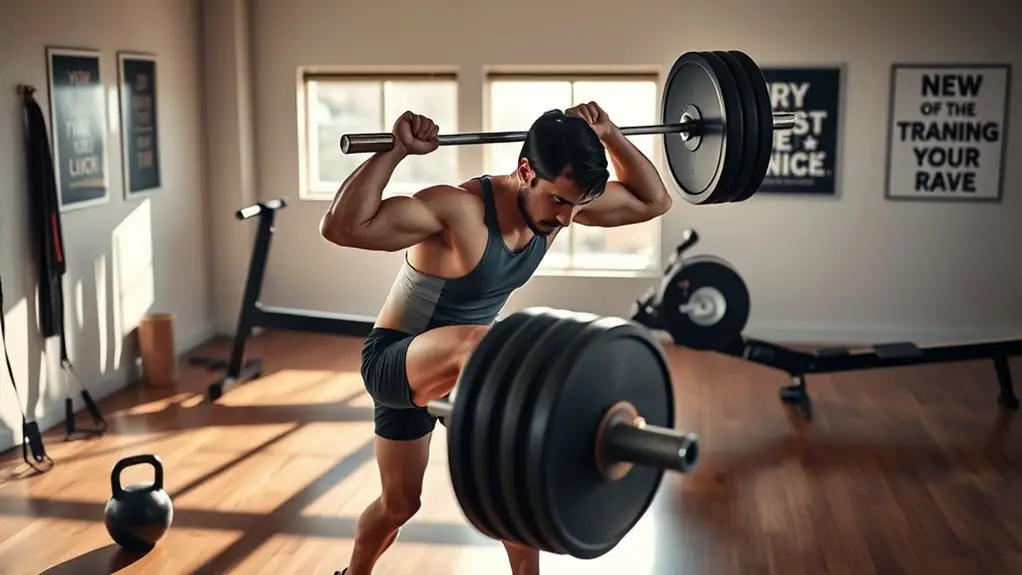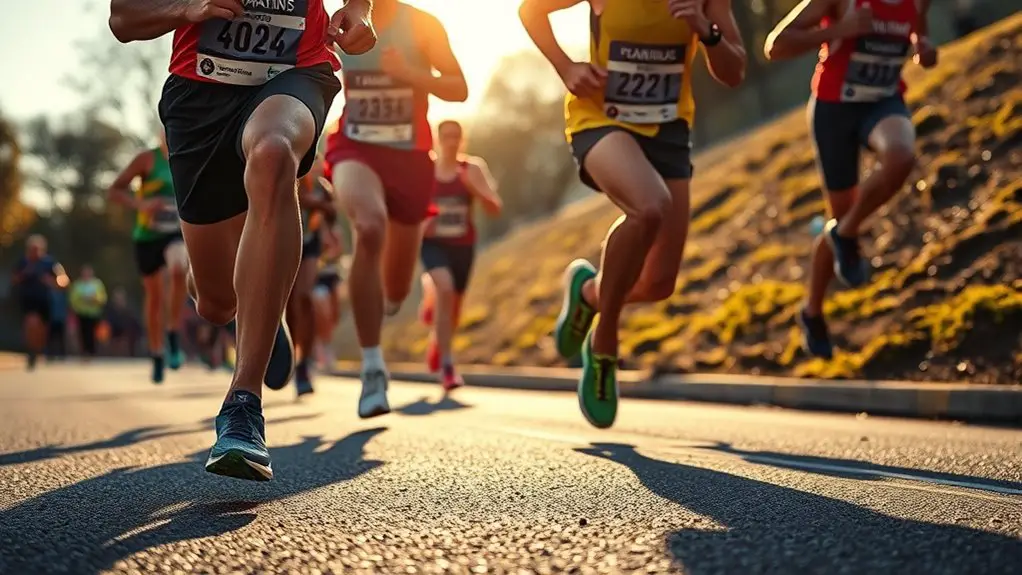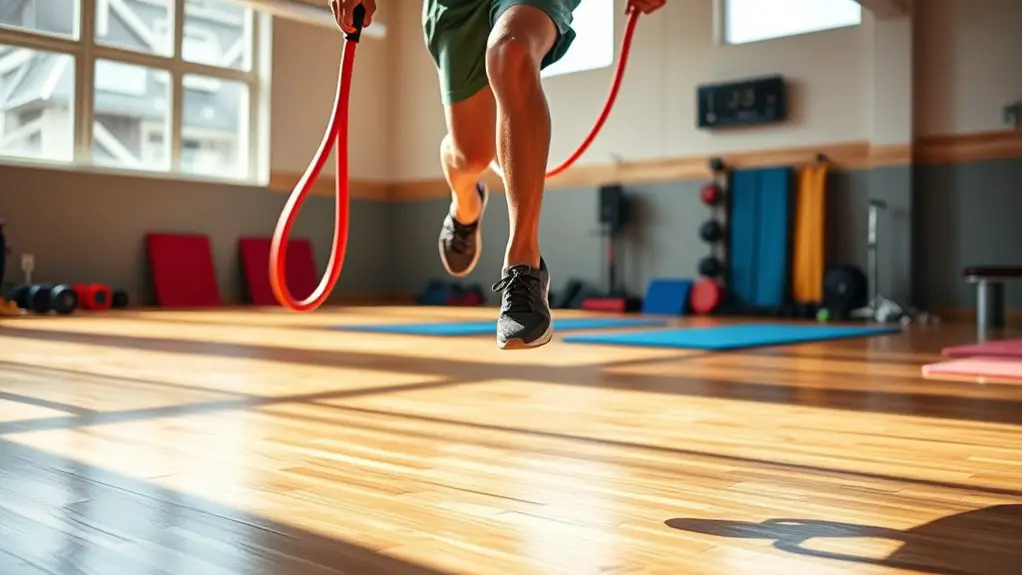To boost your rowing performance, focus on key resistance training exercises. Incorporate bodyweight moves like push-ups and pull-ups for upper body strength, along with squats and lunges to enhance leg power. Utilize free weights with deadlifts and kettlebell swings to develop explosive strength. Resistance bands are also great for mimicking rowing motions. These exercises not only build strength but also help reduce injury risk. Discover more ways to enhance your training as you explore further.
Importance of Resistance Training for Rowers
Although many rowers focus primarily on endurance, incorporating resistance training is vital for enhancing overall performance. It's not just about how long you can row; it's also about how powerful and efficient you can be. By engaging in resistance training, you're building strength that translates directly into your rowing. This means you'll be able to apply more force with each stroke, ultimately improving your speed and efficiency on the water.
Moreover, resistance training helps prevent injuries by strengthening muscles and stabilizing joints, giving you the freedom to row without fear. It enhances your body's ability to recover, allowing you to push your limits while maintaining your passion for the sport. So, whether you're lifting weights or using resistance bands, remember that this training isn't just an add-on; it's a vital part of your journey toward becoming the best rower you can be. Embrace it and enjoy the ride! Additionally, exercises like squats and deadlifts specifically target key muscle groups that are crucial for rowing strength.
Key Muscle Groups for Rowing Performance
To maximize your rowing performance, it's essential to focus on key muscle groups that play a significant role in each stroke. The primary muscles involved are the legs, back, and core. Your legs generate most of the power during the drive phase, with the quadriceps, hamstrings, and calves working in tandem. A strong back, particularly the latissimus dorsi and trapezius, helps maintain proper posture and stability as you pull the oar through the water.
Don't overlook your core, either! A solid core enhances your balance and transfers power efficiently from your legs to your upper body, as core strength acts as the foundation for athletic performance. Additionally, your shoulders and arms, including the biceps and triceps, are critical during the finish of each stroke. By targeting these muscle groups in your resistance training, you'll build the strength and endurance needed to release your full potential on the water, giving you the freedom to row with confidence and power.
Bodyweight Exercises for Enhanced Strength
Building strength in the key muscle groups for rowing can be effectively achieved through bodyweight exercises. These movements allow you to harness your body's weight for resistance, giving you the freedom to train anywhere. Push-ups enhance upper body strength, targeting your chest, shoulders, and triceps, while pull-ups engage your back and arms, vital for powerful strokes.
Incorporating squats and lunges helps develop leg strength and stability, essential for maintaining a strong base during your rowing sessions. Planks and variations challenge your core, improving overall balance and control in the boat. Bodyweight exercises also enhance core stability, which is crucial for maintaining control and balance during rowing movements.
Plus, bodyweight exercises let you focus on form and technique without the intimidation of heavy weights. As you progress, you can modify these exercises to increase difficulty, ensuring you're always challenged. Embrace the versatility of bodyweight training, and you'll notice significant improvements in your rowing performance while enjoying the freedom of movement it offers.
Free Weight Exercises to Build Power
When it comes to building power for rowing, targeting key muscle groups is essential. You'll want to focus on essential free weight moves that engage your legs, back, and core. These exercises not only enhance your strength but also improve your overall rowing performance. Incorporating functional strength training into your routine will help develop the necessary coordination and balance for optimal rowing efficiency.
Key Muscle Groups Targeted
Power is essential for rowers, and targeting key muscle groups through free weight exercises can greatly enhance performance. Focusing on your legs, back, and core will build the strength you need to dominate on the water. Your legs, particularly the quadriceps and hamstrings, provide the driving force during each stroke. Strengthening your back, including the latissimus dorsi and trapezius, helps improve your pull and overall posture. Don't forget your core; a strong core stabilizes your body and transfers power efficiently from your legs to your arms. By engaging these key muscle groups, you'll not only boost your power but also enhance your endurance and reduce the risk of injury. Embrace the freedom that strength training brings to your rowing experience!
Essential Free Weight Moves
To maximize the strength of the key muscle groups you've just focused on, incorporating specific free weight moves into your routine is essential. Start with deadlifts; they'll build power in your posterior chain, vital for that explosive rowing start. Next, add squats to strengthen your legs and core, giving you stability and driving force. Overhead presses are fantastic for shoulder strength, enhancing your control during each stroke. Don't overlook kettlebell swings; they boost your hip power and endurance while keeping your heart rate up. Finally, incorporate bent-over rows to target your back, important for maintaining posture and technique in the boat. By embracing these moves, you'll not only enhance your strength but also gain the freedom to row with confidence and power.
Resistance Bands: Versatile Training Tool
Resistance bands are an incredibly versatile training tool that can enhance your rowing performance. They're lightweight, portable, and perfect for any workout space, giving you the freedom to train wherever you want. With resistance bands, you can mimic the rowing motion, focusing on your pull and core engagement, which is essential for strength and endurance on the water.
You can easily adjust the resistance by using bands of different thicknesses or combining them for a greater challenge. This adaptability allows you to develop strength in a way that feels natural and fluid. Plus, they're great for warming up or cooling down, helping you prevent injuries and maintain flexibility. Incorporating resistance bands into your routine can help you build power, improve your technique, and ultimately elevate your rowing game. Additionally, their injury prevention capabilities make them an ideal choice for athletes looking to train safely. So, grab a band and start exploring the endless possibilities to boost your performance!
Sample Resistance Training Workout Plan
Creating a solid resistance training workout plan is essential for rowers looking to build strength and endurance. You'll want to structure your sessions effectively and include key exercises that target the muscles used in rowing. Let's break down how to optimize your workout timing and the must-have exercises for your routine.
Workout Structure and Timing
While it's essential to tailor your resistance training to your specific rowing needs, having a well-structured workout plan can make all the difference in your performance. Start by scheduling your sessions around your rowing workouts, ensuring you're not overloading your muscles on the same day. Aim for two to three resistance training sessions per week, allowing at least 48 hours between them for recovery. Each session should last about 60 minutes, focusing on compound movements that engage multiple muscle groups. Incorporate a warm-up and cool-down to prevent injury and promote flexibility. Listen to your body, and feel free to adjust the intensity and volume as needed. This approach keeps you energized and ready to conquer the water!
Key Exercises to Include
To maximize your strength and power on the water, incorporating the right exercises into your resistance training is vital. Here are four key exercises you should include to release your potential:
- Deadlifts – Build overall strength and engage your entire posterior chain.
- Pull-Ups – Develop upper body strength, important for powerful rowing strokes.
- Squats – Enhance leg strength and explosiveness for quick starts and sustained speed.
- Bent-Over Rows – Strengthen your back and improve posture, necessary for efficient rowing.
Integrating these exercises into your routine will empower you to break free from limitations and reach new heights in your rowing performance. Embrace the freedom that comes with strength, and watch your skills flourish on the water.
Frequently Asked Questions
How Often Should Rowers Incorporate Resistance Training Into Their Routine?
You should aim to incorporate resistance training into your routine two to three times a week. This frequency helps build strength without overdoing it, allowing for flexibility in your training while ensuring you stay fit and strong.
Can Resistance Training Improve My Rowing Technique?
Imagine a sculptor chiseling away at stone; resistance training refines your strength, allowing your form to flow like a river. It'll enhance your technique, giving you freedom to glide smoothly through every stroke. Embrace the craft!
What Should I Eat Before Resistance Training Sessions?
Before resistance training, you should eat a balanced meal with carbs for energy and protein for muscle support. Light snacks like bananas or yogurt can work, too. Just don't overeat; you want to feel energized, not sluggish!
Is It Safe to Do Resistance Training While Recovering From an Injury?
Around 45% of athletes resume training too soon after injury. It's vital you consult a healthcare professional before starting resistance training again, ensuring you're safely progressing without risking further injury or hindering your recovery.
How Do I Track Progress in Resistance Training for Rowing?
To track progress in resistance training, you can log your workouts, noting weights, reps, and sets. Regularly check your form and endurance too; you'll see improvements that reflect your hard work and dedication.




